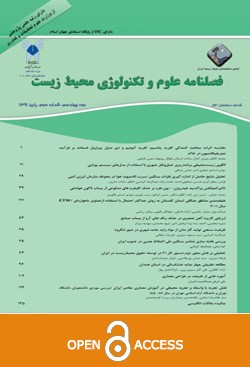کاهش تأثیرات جزایر حرارتی شهری بر سلامت انسانها از طریق تغییرات فرم شهری در اقلیم گرم و خشک شهر مشهد (نمونه موردی الگوی بافت شطرنجی محله شاهد و بافت ارگانیک محله پاچنار)
الموضوعات :
Architecture and urbanism
الهام ثناگر دربانی
1
,
مجتبی رفیعیان
2
,
تکتم حنایی
3
 ,
دانیال منصفی پراپری
4
,
دانیال منصفی پراپری
4
1 - کارشناسی ارشد طراحی شهری، باشگاه پژوهشگران جوان و نخبگان، واحد مشهد، دانشگاه آزاد اسلامی، مشهد، ایران
2 - دانشیار دانشکده هنر و معماری، دانشگاه تربیت مدرس، تهران، ایران( نویسنده مسئول)
3 - استادیار گروه شهرسازی، واحد مشهد، دانشگاه آزاد اسلامی، مشهد، ایران
4 - استادیار دانشکدة مهندسی معماری و شهرسازی، دانشگاه صنعتی شاهرود، شاهرود، ایران
تاريخ الإرسال : 08 الخميس , جمادى الأولى, 1439
تاريخ التأكيد : 10 الأحد , ربيع الأول, 1440
تاريخ الإصدار : 29 الأحد , شوال, 1441
الکلمات المفتاحية:
مشهد,
جزایر حرارتی شهری,
Envi-Met,
فرم شهری,
سلامت انسان,
ملخص المقالة :
زمینه و هدف: افزایش موج گرما در شهرها سبب گردیده تا مشکلات عدیدهای برای سلامت انسانها به وجود آید. کاهش مشکلات زیستمحیطی از طریق تقلیل دمای محیط و درنتیجه ارتقا سلامت انسانها از مهمترین دغدغهها در عصر حاضر است که میتوان بهوسیله تغییرات فرمهای شهری و عناصر محیطی به آن دستیافت.
روش بررسی: در این پژوهش از روش شبیهسازی مجموعه نرمافزار Envi-Met و Leonardo استفادهشده است.
یافتهها: یافتهها حاکی از آن است که هرچقدر نسبت ارتفاع به عرض بیشتر شود، دسترسی نور خورشید به محیط کمتر میشود و درنتیجه دمای محیط کاهش مییابد. همچنین سایهاندازی ناشی از نسبت (H/w)، وجود گیاهان و باد در درههای شهری میتواند دمای محیط را کاهش دهد. علاوه بر آن کاهش سطوح نفوذناپذیر پوششهای شهری و وجود مصالح با آلبدوی بالا، باعث افزایش در تبخیر و تعرق میشود که شرایط خنکتر شدن محیطهای شهری را مهیا میکند و سبب کاهش تأثیرات نامطلوب گرمای شهری بر سلامت انسان میشود.
بحث و نتیجهگیری: میتوان نتیجه گرفت که ایجاد سایهاندازی از طریق ترکیب پوشش گیاهی و همچنین ایجاد تغییرات متنوع در ساختارهای ارتفاع به عرض (H/w) که هم سایهاندازی را افزایش دهد و هم در بخشهایی راه را برای انتشار گرمای محیط بازنماید، میتواند در کاهش دمای محیط و سطوح، تأثیرگذار باشد. همچنین استفاده از سطوح شهری نفوذپذیر و انتخاب مصالح جدارههای ساختمانها با بازتابش کم در جذب کمتر نور خورشید تأثیرگذار است و میتواند شدت جزایر حرارتی شهری را کاهش دهد.
المصادر:
- Akbari, H. 2005. Energy Saving Potentials and Air Quality Benefits of Urban HeatIslandMitigation: Lawrence Berkeley National Laboratory: Lawrence Berkeley National Laboratory.
- Yahia, M. W., Johansson, E., Thorsson, S., Lindberg, F., Rasmussen, M. I. 2017. Effect Of Urban Design On Microclimate And Thermal Comfort Outdoors In Warm-Humid Dar Es Salaam, Tanzania. International Journal of Biometeorology,Vol.62,No.3,pp.373-385
Ahmadpour,N., Pourjafar,M. ; Mahdavinejad ,M., Yousefian.,S,.2017. The Role and Impact of Design Elements on the Quality of Thermal Comfort in Urban Open Spaces Case Study: Design of Pedestrian Way in Tamghachiha Pathway in the City of Kashan. Journal Of Architecture and Urban Planning,Vol9,No.18.pp.59-80 (persian).
Bruse, M. 2015. ENVI-metModel Homepage: https://www.envi-met.com
Bruse, M. Simulating microscale climate interactions in complex terrain with a high- resolution numerical model: A case study for the Sydney CBD Area (Model Description). Paper presented at the International Conference on Urban Climatology & international congress of biometeorology,1999, Sydney, Australia.
Wang, Y., & Akbari, H. 2016. The effects of street tree planting on Urban Heat Island mitigation in Montreal. Sustainable Cities and Society, Vol. 27, pp.122-128
Che-Ani, A. I., Shahmohamadi, P., Sairi, A., Mohd-Nor, M. F. I., Sain, M. F. M., Surat, M. 2009. Mitigating the urban heat island effect: Some points without altering existing city planning. European Journal of Scientific Research,Vol. 35, No. 2,pp.204-216.
Gupta, S., Anand, P., Shashwat. 2015. Improvement of outdoor thermal comfort for a residential development in Singapore. International Journal of Energy and Environment (IJEE), Vol.6,No.6, pp.567-586
Monsefi Parapari, D. Adaptation to Climate Change and Thermal Comfort. PHD Dissertation, Dortmund University of Technology,2015,pp.259
WHO. 2007. The Large Analysis and Review of European Housing and Health Status (LARES). Retrieved from Copenhagen, Denmark: http://www.euro.who.int/en/health-topics/environment-and-health/Housing-and-health/activities/the-large-analysis-and-review-of-european-housing-and-health-status-lares-project.
Linares, C., & Dı´az, J. 2007. Impact of high temperatures on hospital admissions: comparative analysis with previous studies about mortality (Madrid). European Journal of Public Health,Vol. 18,No. 3, pp.317–322.
Pirard, P., Vandentorren, S., Pascal, M., Laaidi, K., Le Tertre, A., Cassadou, S., Ledrans, M. 2005. Summary Of The Mortality Impact Assessment Of The 2003 Heat Wave In France. Euro Surveill,Vol.10, No.7,pp. 153–156
Yang, L., Qian, F., Song, D.-X., Zheng, K.-J. 2016. Research on Urban Heat-Island Effect. Procedia Engineering, Vol.169, pp.11-18
Hansen, A., Bi, P., Nitschke, M., Ryan, P., Pisaniello, D., Tucker, G. 2008. The effect of heat waves on mental health in a temperate Australian city, Environ. Health Perspect,Vol. 116,pp. 1369–1375.
Ünlü, T. 2011. Towards the Conceptualization of Piecemeal Urban Transformation: The Case of Mersin, Turkey. Built Environment, Vol. 37,No.4, pp.445-461
Saud Alznafer, B. M. The Impact Of Neighbourhood Geometries On Outdoor Thermal Comfort And Energy Consumption From Urban Dwellings A Case Study Of The Riyadh City, The Kingdom Of Saudi Arabia. PHD Dissertation , Cardiff University,2014,pp.373.
Krüger, E. L., Minella, F. O., Rasia, F. 2011. Impact of urban geometry on outdoor thermal comfort and air quality from field measurements in Curitiba, Brazil. Building and Environment, Vol.46,No.3, pp.621-634
Esther, M. M., & Sagada, M. L. 2014. An Evaluation Of Thermal Comfort Conditions In An Urban Entertainment Centre In Hot-Dry Climate Of Nigeria. International Journal of Energy and Environmental Research, Vol.2, No. 1,pp. 55-74
Abreu-Harbich, L. V., Labaki, L. C., & Matzarakis, A. 2014. Thermal bioclimate in idealized urban street canyons in Campinas. Brazil Theoretical and Applied Climatology, Vol.115,No.(1-2),pp.115-223
Georgi, N., Tzesouri, A. Monitoring Thermal Comfort in Outdoor Urban Spaces for Bioclimatic Conditions Improvement, 1st WSEAS International Conference On Landscape Architecture,2008, Portugal.
Rodríguez Algeciras , J. A., Consuegra, L. G. a., & Matzarakis, A. 2016. Spatial-temporal study on the effects of urban street configurations on human thermal comfort in the world heritage city of Camagüey-Cuba. Building and Environment, ). Impact of High Temperatures on Mortality: Is There an Added Heat Wave Effect, Voll.101,pp. 85-101
Lilly Rose, A., Devadas, M. D. Analysis of Land Surface Temperature and Land Use/Land Cover Types Using Remote Sensing Imagery - A Case In Chennai City, India The seventh International Conference on Urban Clim, 2009,Yokohama, Japan.
Jamei, E., Rajagopalan, P., Seyedmahmoudian, M., Jamei, Y. 2016. Review On The Impact Of Urban Geometry And Pedestrian Level Greening On Outdoor Thermal Comfort. Renewable and Sustainable Energy Reviews,Vol. 54,pp. 1002–1017
Arnfield , J. 2003. Two decades of urban climate research: A review of turbulence, exchanges of energy and water, and the urban heat island. International Journal of Climatology, Vol.23,No.1,pp. 1-26
Oke, T. R. 1988. Street Design and Urban Canopy Layer Climate. Energy and Buildings, Vol.11, No.1-3.
Middel, A., Häb, K., Brazel, A. J., Martin, C. A., Guhathakurta, S. 2014. Impact of urban form and design on mid-afternoon microclimate in Phoenix Local Climate Zones. Landscape and Urban Planning, Vol.122, pp.16-28
Azmoodeh,M., Heidari,S,.2017. Effect of Urban Green Walls on Reduction of Temperature in Microclimates and Urban Heat Island. Journal of Environmental Science and Technology,Vol.19,No.5,597-606 (persian).
_||_
- Akbari, H. 2005. Energy Saving Potentials and Air Quality Benefits of Urban HeatIslandMitigation: Lawrence Berkeley National Laboratory: Lawrence Berkeley National Laboratory.
- Yahia, M. W., Johansson, E., Thorsson, S., Lindberg, F., Rasmussen, M. I. 2017. Effect Of Urban Design On Microclimate And Thermal Comfort Outdoors In Warm-Humid Dar Es Salaam, Tanzania. International Journal of Biometeorology,Vol.62,No.3,pp.373-385
Ahmadpour,N., Pourjafar,M. ; Mahdavinejad ,M., Yousefian.,S,.2017. The Role and Impact of Design Elements on the Quality of Thermal Comfort in Urban Open Spaces Case Study: Design of Pedestrian Way in Tamghachiha Pathway in the City of Kashan. Journal Of Architecture and Urban Planning,Vol9,No.18.pp.59-80 (persian).
Bruse, M. 2015. ENVI-metModel Homepage: https://www.envi-met.com
Bruse, M. Simulating microscale climate interactions in complex terrain with a high- resolution numerical model: A case study for the Sydney CBD Area (Model Description). Paper presented at the International Conference on Urban Climatology & international congress of biometeorology,1999, Sydney, Australia.
Wang, Y., & Akbari, H. 2016. The effects of street tree planting on Urban Heat Island mitigation in Montreal. Sustainable Cities and Society, Vol. 27, pp.122-128
Che-Ani, A. I., Shahmohamadi, P., Sairi, A., Mohd-Nor, M. F. I., Sain, M. F. M., Surat, M. 2009. Mitigating the urban heat island effect: Some points without altering existing city planning. European Journal of Scientific Research,Vol. 35, No. 2,pp.204-216.
Gupta, S., Anand, P., Shashwat. 2015. Improvement of outdoor thermal comfort for a residential development in Singapore. International Journal of Energy and Environment (IJEE), Vol.6,No.6, pp.567-586
Monsefi Parapari, D. Adaptation to Climate Change and Thermal Comfort. PHD Dissertation, Dortmund University of Technology,2015,pp.259
WHO. 2007. The Large Analysis and Review of European Housing and Health Status (LARES). Retrieved from Copenhagen, Denmark: http://www.euro.who.int/en/health-topics/environment-and-health/Housing-and-health/activities/the-large-analysis-and-review-of-european-housing-and-health-status-lares-project.
Linares, C., & Dı´az, J. 2007. Impact of high temperatures on hospital admissions: comparative analysis with previous studies about mortality (Madrid). European Journal of Public Health,Vol. 18,No. 3, pp.317–322.
Pirard, P., Vandentorren, S., Pascal, M., Laaidi, K., Le Tertre, A., Cassadou, S., Ledrans, M. 2005. Summary Of The Mortality Impact Assessment Of The 2003 Heat Wave In France. Euro Surveill,Vol.10, No.7,pp. 153–156
Yang, L., Qian, F., Song, D.-X., Zheng, K.-J. 2016. Research on Urban Heat-Island Effect. Procedia Engineering, Vol.169, pp.11-18
Hansen, A., Bi, P., Nitschke, M., Ryan, P., Pisaniello, D., Tucker, G. 2008. The effect of heat waves on mental health in a temperate Australian city, Environ. Health Perspect,Vol. 116,pp. 1369–1375.
Ünlü, T. 2011. Towards the Conceptualization of Piecemeal Urban Transformation: The Case of Mersin, Turkey. Built Environment, Vol. 37,No.4, pp.445-461
Saud Alznafer, B. M. The Impact Of Neighbourhood Geometries On Outdoor Thermal Comfort And Energy Consumption From Urban Dwellings A Case Study Of The Riyadh City, The Kingdom Of Saudi Arabia. PHD Dissertation , Cardiff University,2014,pp.373.
Krüger, E. L., Minella, F. O., Rasia, F. 2011. Impact of urban geometry on outdoor thermal comfort and air quality from field measurements in Curitiba, Brazil. Building and Environment, Vol.46,No.3, pp.621-634
Esther, M. M., & Sagada, M. L. 2014. An Evaluation Of Thermal Comfort Conditions In An Urban Entertainment Centre In Hot-Dry Climate Of Nigeria. International Journal of Energy and Environmental Research, Vol.2, No. 1,pp. 55-74
Abreu-Harbich, L. V., Labaki, L. C., & Matzarakis, A. 2014. Thermal bioclimate in idealized urban street canyons in Campinas. Brazil Theoretical and Applied Climatology, Vol.115,No.(1-2),pp.115-223
Georgi, N., Tzesouri, A. Monitoring Thermal Comfort in Outdoor Urban Spaces for Bioclimatic Conditions Improvement, 1st WSEAS International Conference On Landscape Architecture,2008, Portugal.
Rodríguez Algeciras , J. A., Consuegra, L. G. a., & Matzarakis, A. 2016. Spatial-temporal study on the effects of urban street configurations on human thermal comfort in the world heritage city of Camagüey-Cuba. Building and Environment, ). Impact of High Temperatures on Mortality: Is There an Added Heat Wave Effect, Voll.101,pp. 85-101
Lilly Rose, A., Devadas, M. D. Analysis of Land Surface Temperature and Land Use/Land Cover Types Using Remote Sensing Imagery - A Case In Chennai City, India The seventh International Conference on Urban Clim, 2009,Yokohama, Japan.
Jamei, E., Rajagopalan, P., Seyedmahmoudian, M., Jamei, Y. 2016. Review On The Impact Of Urban Geometry And Pedestrian Level Greening On Outdoor Thermal Comfort. Renewable and Sustainable Energy Reviews,Vol. 54,pp. 1002–1017
Arnfield , J. 2003. Two decades of urban climate research: A review of turbulence, exchanges of energy and water, and the urban heat island. International Journal of Climatology, Vol.23,No.1,pp. 1-26
Oke, T. R. 1988. Street Design and Urban Canopy Layer Climate. Energy and Buildings, Vol.11, No.1-3.
Middel, A., Häb, K., Brazel, A. J., Martin, C. A., Guhathakurta, S. 2014. Impact of urban form and design on mid-afternoon microclimate in Phoenix Local Climate Zones. Landscape and Urban Planning, Vol.122, pp.16-28
Azmoodeh,M., Heidari,S,.2017. Effect of Urban Green Walls on Reduction of Temperature in Microclimates and Urban Heat Island. Journal of Environmental Science and Technology,Vol.19,No.5,597-606 (persian).
![]() ,
دانیال منصفی پراپری
4
,
دانیال منصفی پراپری
4


